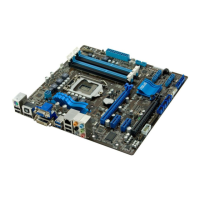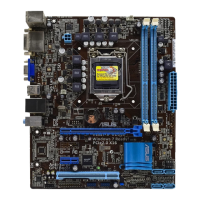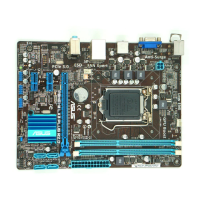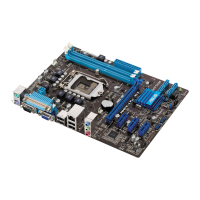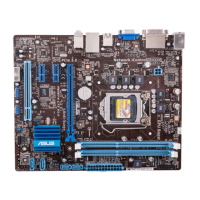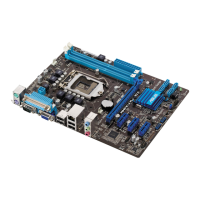
Do you have a question about the Asus P8H61-M PLUS V3 and is the answer not in the manual?
| Form Factor | Micro ATX |
|---|---|
| Chipset | Intel H61 |
| CPU Socket | LGA 1155 |
| Memory Slots | 2 x DIMM |
| Maximum Memory | 16 GB |
| Memory Type | DDR3 |
| Memory Standard | DDR3 2200(O.C.)/2133(O.C.)/2000(O.C.)/1866(O.C.)/1600/1333/1066 MHz |
| Storage Interface | 4 x SATA 3Gb/s |
| Audio | Realtek ALC887 8-Channel High Definition Audio CODEC |
| Max. LAN Speed | 10/100/1000 Mbps |
| Video Outputs | 1 x D-Sub, 1 x DVI-D |
| Expansion Slots | 2 x PCIe 2.0 x1 |
| LAN | Realtek 8111F |
| Power Connector | 1 x 24-pin EATX Power, 1 x 4-pin ATX 12V Power |
Guidelines to prevent electric shock hazards and ensure safe operation.
Best practices for handling and installing the motherboard and components safely.
Explains the organization and parts of the user guide for easy navigation.
Directs users to ASUS websites and optional documentation for more details.
Explains symbols used to convey critical information and warnings within the manual.
Details typography like bold text, italics, and key notations for user understanding.
Lists specifications for the Central Processing Unit and the motherboard chipset.
Details memory types, capacity, and available expansion slot types.
Outlines connectivity options including storage, network, audio, and USB ports.
Highlights proprietary technologies and features integrated into the motherboard.
Lists rear panel ports and internal connectors/switches for system integration.
Details BIOS capabilities, included accessories, and support media.
Specifies the physical dimensions and form factor of the motherboard.
Important precautions and checks before starting motherboard installation.
Explains the function of the onboard standby power LED for system status.
Instructions on orienting the motherboard correctly within the chassis.
Details the process of using screws to mount the motherboard securely.
Visual representation of the motherboard's key components and connectors.
Table detailing the function and location of motherboard connectors, jumpers, and slots.
Step-by-step guide for safely installing the CPU into the LGA1155 socket.
Detailed steps for mounting the CPU heatsink and fan assembly for proper cooling.
Procedures for safely removing the CPU heatsink and fan assembly.
Introduction to the motherboard's DDR3 DIMM sockets and their specifications.
Guidance on installing different memory modules and capacity limits.
List of tested and compatible memory modules for optimal performance.
Explains the difference between single-sided (SS) and double-sided (DS) memory modules.
Details how to install one or two DIMMs for single or dual-channel memory configurations.
Step-by-step instructions for inserting a memory module into the DIMM socket.
Step-by-step instructions for safely removing a memory module from the socket.
Guidance on adding and setting up expansion cards like PCI and PCIe.
Details the specifications and uses of PCI, PCIe x1, and PCIe x16 slots.
Explains the function and usage of the CLRTC jumper for clearing CMOS data.
Identifies and describes the ports located on the motherboard's rear panel.
Details specific rear panel ports for peripherals and display.
Describes the connector for front panel HD Audio or AC'97 audio module.
Explains the connection of ATX power supply plugs for system power.
Details the connector for chassis intrusion detection sensors or switches.
Guides on connecting CPU and chassis fan cables to motherboard headers.
Explains the S/PDIF Out connector for digital audio output.
Details the SATA connectors for connecting hard drives and optical drives.
Describes the internal headers for connecting additional USB 2.0 ports.
Explains the connector for chassis-mounted functions like power/reset buttons and LEDs.
Details the connector for the system warning speaker.
Recommendations for installing OS versions for compatibility and stability.
Information on drivers, utilities, and software provided on the support DVD.
Overview of BIOS management and backup procedures using ASUS Update utility.
Guide on installing and using the ASUS Update utility within the Windows environment.
Instructions for updating BIOS using a saved BIOS file.
Details on updating BIOS directly from the BIOS setup using a USB flash drive.
Explains the auto-recovery tool for restoring corrupted BIOS files.
Guide for updating BIOS in a DOS environment using the ASUS BIOS Updater utility.
Methods to access the BIOS setup utility at system startup or after POST.
Introduction to the EZ Mode interface for basic system information and settings.
Overview of the Advanced Mode interface, including menus and configuration fields.
Explains how to navigate menus, use keys, and understand on-screen help.
Details how to interact with configuration fields and pop-up windows for settings.
How to configure system language, date, and time within the BIOS.
Introduction to the security settings available in the BIOS.
Procedures for setting, changing, or clearing the administrator BIOS password.
Procedures for setting, changing, or clearing the user BIOS password.
Options for setting the memory operating frequency for performance tuning.
Adjustments for the integrated graphics processor's maximum frequency.
Settings for power phase control and GPU performance optimization.
Options for fine-tuning DRAM timing parameters for performance.
Settings related to CPU features, performance, and core management.
Settings for Execute Disable Bit, Virtualization, and Prefetcher functions.
Options for managing CPU power states and technologies like EIST and Turbo Mode.
Settings related to the Platform Controller Hub (PCH) and High Precision Timer.
Configuration for Intel Rapid Start Technology for faster system resume.
Settings for SATA mode (IDE/AHCI) and SMART status checks.
Settings for memory remapping and graphics controller configuration.
Options for legacy USB support and EHCI hand-off.
Settings for HD audio controller, front panel type, SPDIF, and LAN controller.
Configuration options for serial (COM) and parallel (LPT) ports.
Power management features like AC power loss recovery and wake-on settings.
Settings for waking the system via specific events or devices.
Options for enabling the UEFI network stack and PXE boot support.
Displays real-time system temperatures and voltage readings.
Shows fan speeds and provides access to fan control settings.
Details monitoring of CPU temperature and fan speed (RPM).
Configuration options for CPU fan speed control based on temperature profiles.
Configuration options for chassis fan speed control based on temperature.
Enables or disables the Anti Surge protection feature for system safety.
Sets the NumLock state when the system powers on.
Options for displaying a full screen logo and handling boot errors.
Controls display of third-party ROM messages and default BIOS setup mode.
Settings for selecting UEFI or Legacy boot modes and ROM priority.
Defines the sequence of boot devices and allows temporary boot override.
Utility for flashing the BIOS from within the BIOS environment.
Displays Serial Presence Detect (SPD) information for installed DIMM modules.
Allows saving and loading BIOS settings profiles for overclocking.
Options to load default settings or save modified settings and reset the system.
Option to exit the BIOS setup without saving any changes.
Compliance statements for Federal Communications Commission regulations.
Compliance information for Industry Canada regulations.
Compliance statements for Japan (VCCI), Korea (KC), and EU REACH framework.
Guidelines for environmentally responsible disposal of the motherboard and batteries.
Addresses and contact details for ASUS headquarters.
Contact details and online support links for different geographic regions.
Formal declaration of compliance with FCC rules and regulations.
Declaration of conformity with EU directives and CE marking information.



